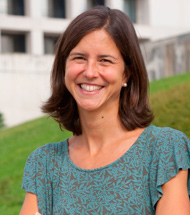Silvia Carlos Chilleron, Professor and researcher at the Institute of Tropical Health (ISTUN) of the University of Navarra and collaborator of the Institute for Culture and Society
YES.DA steps forward in the fight against AIDS
 Do they tell me, can I do something to make progress in the fight against AIDS? YES. Each of us can take action. But to make progress on something you first have to know about it. Knowing that there are currently an estimated 37 million HIV-infected people in the world and that there are around 2 million new diagnoses each year (more than 3,000 in our country). And many more people suffer the physical, psychological, family and social consequences of this infection.
Do they tell me, can I do something to make progress in the fight against AIDS? YES. Each of us can take action. But to make progress on something you first have to know about it. Knowing that there are currently an estimated 37 million HIV-infected people in the world and that there are around 2 million new diagnoses each year (more than 3,000 in our country). And many more people suffer the physical, psychological, family and social consequences of this infection.
However, it is also necessary to know that little by little progress is being made and this picture is getting some colour: in some places today the population is becoming more aware of HIV, its transmission and prevention. So, little by little, step by step, the numbers can be reduced. Let's take steps.
Step one. Let's prevent new infections. HIV is a virus that is currently transmitted mainly sexually, either in heterosexual couples or, as is the case mainly in our country or in other economically developed countries, in homosexual men. And new cases, as is the case for other sexually transmitted infections (genital herpes, syphilis, gonorrhoea or Chlamydia, among others), occur mainly in the young population. In our country, about one third of new HIV diagnoses are made in the 20-29 year old population. We need to help young people in particular not to add to these figures and to do so we need to make them aware of this reality. What may seem like "safe sex" to them today may become the opposite tomorrow; what is an occasional contact one day may become a perpetual effect in the future. Today we know that we press a single key and send a whatsapp to multiple contacts, everyone is statement with everyone. But we don't stop to think that bacteria, viruses, parasites and fungi can just as easily be transmitted in the context of multiple sexual contacts. Let's get the real message across.
Step two. Diagnose infected people as early as possible. In Spain, 46% of new HIV diagnoses are diagnosed late. In other words, it can take years before almost half of those infected discover that they are infected. In our environment, this means on the one hand that someone who is HIV positive is missing the opportunity to receive timely antiretroviral treatment and, therefore, the consequences of the infection. But in addition, an infected person, as is the case with other sexually transmitted infections, can be asymptomatic and even appear healthy, and yet be a potential source source of new infections. There is a high percentage of the population that does not perceive this risk, and raising awareness does not mean scaring, it means informing. Every day, different health professionals report multiple and varied diagnoses, after an ophthalmological check-up, a blood pressure measurement, a diabetes test or a cancer screening. The problem is that until now, HIV diagnosis has had a different label . Probably what has made it different has been, on the one hand, its sexual transmission route, which is still taboo in our society, and, above all, the higher incidence of infection in population groups that are often excluded. But, like others, it is a virus, a microscopic spherical particle of about 100 nanometres, which, like other agents, attacks our defences. In this case, however, it also attacks other defences that prevent HIV-positive people from coping with the social pressures they may face. Let's take label off HIV and encourage early diagnosis.
Step three. Let us work to get treatment for all infected people. There are drugs, getting better and better, easier and easier to take. Between 2010 and 2015, the number of people with access to antiretrovirals rose from 7.5 million to 17 million. However, there are still many people without access and many who do not even know what they could be accessing. Currently, 70% of HIV infections occur in sub-Saharan Africa, where in some countries, one in five people are infected. Unfortunately, in this region, less than a third of the infected population has access to treatment, compared to 60% in Europe or the United States. A lot of work is being done on this goal, but we are still a long way off.
Let's not let time pass, there are children and adults waiting, there are families and communities that can move forward. Let's take steps.
